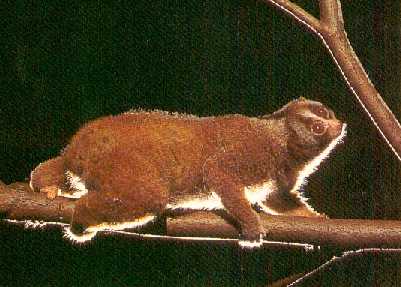|
Animal Spotlight
February 2003 It was a typical morning, the start of a brand new day at the Singapore Zoological Gardens. The staff have started work and the phone is ringing constantly at the reception with members of the public enquiring about everything from the price of the tickets to animal show times. Then at round 9.00am in the morning, an identified person called the reception and reported that he spotted a mysterious cardboard fruit carton in the zoo carpark. He claimed that there could be some animal inside the box because it moved. Minutes later, the animal management officer on duty received the message through his walkie-talkie and together with another keeper, they set off to investigate. The duo scanned the entire carpark on their buggy and finally spotted a suspicious looking carton at the corner furthest from the zoo entrance. Upon approaching, the officer and keeper realised that some small holes had been deliberately punched on the cover, an indication that a live animal must be inside. To prevent an escape, they loaded the entire box onto the buggy and proceeded to bring the animal to the vet for a medical check up. At the clinic, the vet opened the box carefully and it revealed a pair of large round eyes that clearly expressed fear. Wearing protective gloves, the vet picked up the little furball around the neck carefully to avoid the sharp teeth. A thorough examination was done on this malnourished animal known as the Slow Loris. The poor creature was merely skin and bones with hardly any fur left on its once lustrous body. Such an incident was nothing new to the vet and other zoology staff at the zoo. There are plenty of such sad cases every year in Singapore where people got tired of their exotic pets and especially when the owners lacked the skills and knowledge to care for the animals properly, the poor creatures often suffered from health problems. At least some people had the 'conscience' to abandon their former pets at the zoo (mostly discreetly) in the hope that the zoo might take them in. It will take months before this Slow Loris can recover fully and grow back all its fur. It will need to be rehabilitated for an arboreal life and hopefully get used to other slow lorises. This will be a long and slow process that requires time and dedication from those who will now care for it. This slow loris will also join the long lists of other slow lorises, as well as tarsiers, gibbons, all kinds of snakes and some reptiles (e.g. iguanas), etc. that have been abandoned (by irresponsible individuals) or confiscated (by AVA) from all over Singapore. People often think that keeping certain wild animals, from Tree Frogs and Star Tortoises to Cobras and Chameleons, as pets is very cool and something different form having 'common ' pets. But do they have the time, space, resources, skills and knowledge to care for their charges? Unfortunately, very few have..... P.S. There is even a rumour (or truth) that someone is keeping a pet tiger right here in Singapore!! Simply unbelievable !! To want keep a pet tiger here is ridiculous and it is very difficult to hide it unless this owner has a big house and does not invite friends over. Can only guess it could be a very drastic fengshui reason for risking it all.......or the person is simply crazy!!
Acknowledgements - Facts on the Slow Loris from Wildlife Fact File and Docent Training CD-Rom, Photo from Night Safari.
Back to
Home | Explore | Rangers’ Station | Walking Trails | Tram Ride | Resources
|
|||||||



